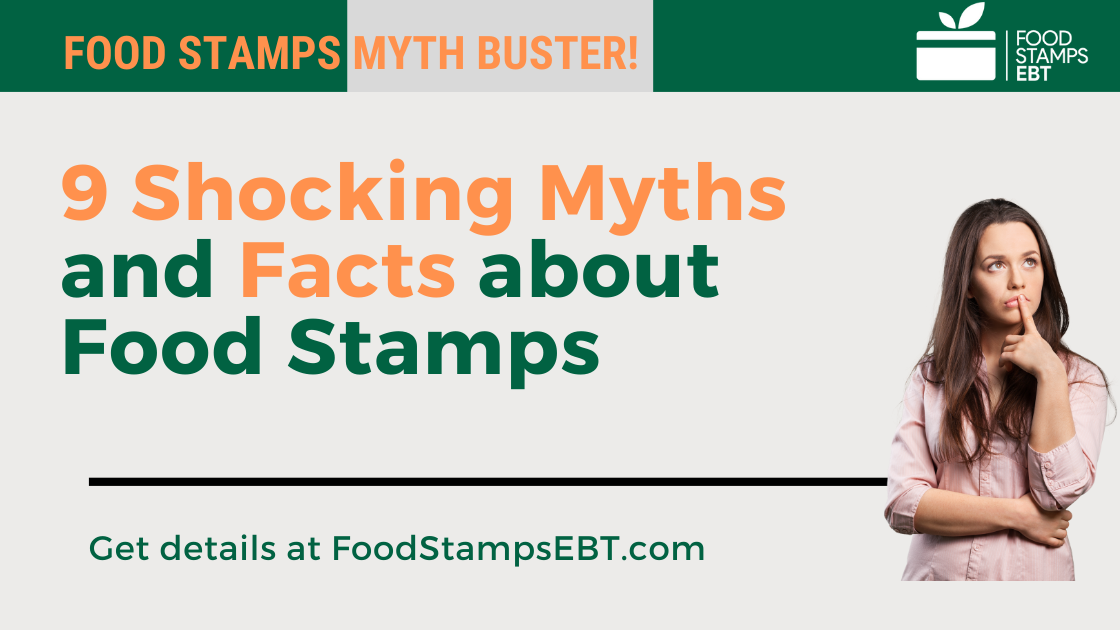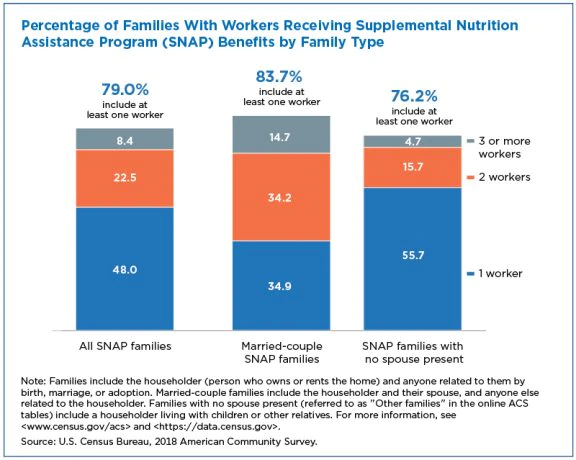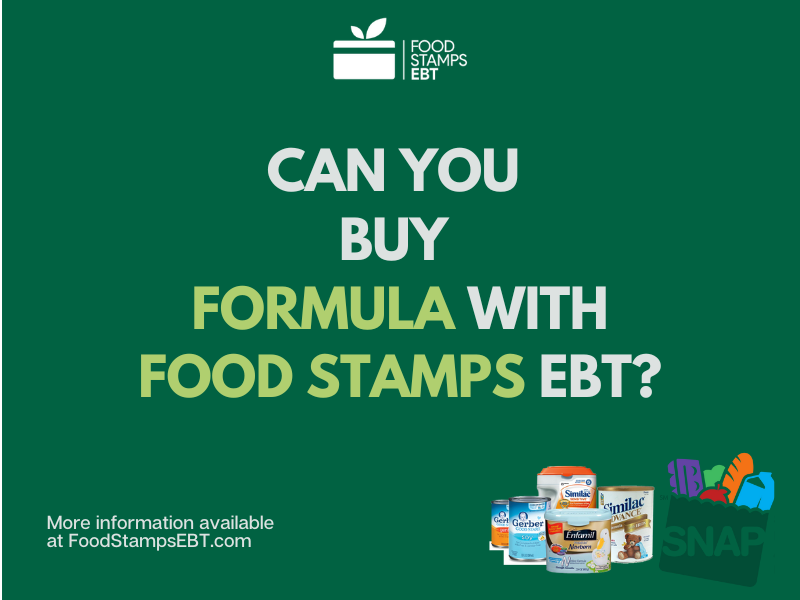There are a lot of myths about food stamps the people who receive them. As a result, there are many who are eligible for the program, especially seniors, who don’t apply because of the stigma attached to the program. Additionally, those who receive food stamps become a target for falsehoods and misinformation. In this post, we will highlight 9 myths and facts about food stamps. Our goal is to debunk the top myths and misinformation about the program with facts.
What are Food Stamps?
Supplemental Nutrition Assistance Program (SNAP), formerly called Food Stamps, helps low-income people buy the food they need for good health.
SNAP served close to 40 million Americans in 2021 (as of September 2021).
You may be able to get SNAP benefits if you are:
- Working for low wages or working part-time;
- Unemployed;
- Receiving welfare or other public assistance payments;
- Elderly or disabled and are low-income; or
- Homeless.
State public assistance agencies run the program through their local offices.
The United States Department of Agriculture sets the basic rules for the program but states are permitted to have additional rules specific to their program.
Once you are approved for SNAP, your state will issue benefits each month on a plastic electronic benefits transfer (EBT) card.
Much like a credit or debit card, you can use your EBT card to buy eligible food items from authorized SNAP grocery, convenience stores, and participating farmers’ markets.
9 Shocking Myths and Facts about Food Stamps
There are a lot of myths, falsehoods, and misconceptions about the SNAP program and the people who receive them.
Our goal with this post is to separate the myths from the truth about SNAP.
Here are 9 must-know facts about SNAP you may not know.
1. The majority of Recipients are elderly, disabled, or children
There is a common misconception that food stamps recipients are lazy individuals taking advantage of the social safety net.
However, about 75 percent of SNAP households include children (under age 18), elderly people (age 60 or older), or individuals with disabilities.
Elderly individuals make up 11 percent of SNAP participants, and this number is likely to grow as our population continues to age
Children make up the largest percentage of SNAP recipients, representing 44 percent of all SNAP participants.
SNAP protects millions of children from food insecurity, which can lead to depression, attention deficit disorder, and other negative long-term health effects in children.
2. About 80% of SNAP Households are Poor
Do SNAP benefits really go to those who really need them?
The answer is Yes!
SNAP focuses benefits on households with the lowest incomes.
Households in poverty receive about 92% of SNAP benefits, and households in deep poverty receive 55% of all SNAP benefits.
SNAP benefits average only about $1.81 per person per meal.
However, despite a modest benefit that may be inadequate for many families, SNAP has contributed to measurable improvements in the health and well-being of Americans.
Here’s what the data shows:
Over 80 percent of food stamps benefits go to households with incomes below the federal poverty line. In 2021, that’s $21,960 annually for a family of three.
Furthermore, 40 percent of recipients live in deep poverty, defined as below $9,765 annually for a family of three in 2019.
3. SNAP Is Designed to Encourage Work
Another often cited misconception about SNAP is that it discourages people from seeking employment.
This is not supported by facts.
The majority of SNAP participants who can work, do work.
According to the Census Bureau report released in 2020, Of the 3.4 million married-couple families receiving SNAP benefits, 84% had at least one worker (see image below).
Additionally, nearly half (49%) had two or more workers. These data show that SNAP provides nutritional support for many U.S. working families.
Furthermore, during the Great Recession, employment rates among SNAP households with children and at least one non-disabled adult rose nearly 10 percent from 2009 to 2015.
4. SNAP Favors Earnings Over Unearned Income
Another little-known fact is that the SNAP program is designed to give preferential treatment to earned income over unearned income (like Social Security or cash assistance).
First, the program disregards 20 percent of earned income when calculating benefits.
This disregard is meant to reflect income spent on work-related expenses like transportation and clothing that is therefore not available for food purchases.
As a result of the earnings deduction, a household with earnings will receive a larger SNAP benefit than a household of the same size and gross income in which income comes from unearned sources.
So an unemployed worker who has the opportunity to replace his income from unemployment insurance or cash assistance with earnings will take home more total income with earnings and SNAP than with unearned income and SNAP.
The table below, from the Center for Budget and Policy Priorities, demonstrates how the SNAP program favors earned income over unearned income.
5. The Average Benefit is $5.45 per Day
There is a misconception that SNAP benefits provide recipients an opportunity to eat well on the taxpayer’s dime. This is far from the truth.
In 2018, the average SNAP recipient received about $127 a month (or about $4.17 a day, $1.39 per meal).
Why is the rate so low?
It’s because there has not been a real purchasing power adjustment of SNAP benefit amount since 1975.
Modest Increase in 2021
That changed in October 2021 when the Biden administration made changes to the U.S. Department of Agriculture’s Thrifty Food Plan.
The Thrifty Food Plan (TFP) is the most frugal of the four plans that the U.S. Department of Agriculture (USDA) develops to estimate the costs and contents of a healthy diet.
The USDA uses the plan as a basis for determining the maximum amount of SNAP benefits available to families.
However, for years, SNAP recipients, anti-hunger advocates, and academic experts have argued that the TFP underestimates the cost of a nutritionally adequate diet.
To address these concerns, Congress directed the USDA to regularly reevaluate the TFP using recent dietary guidance and current food prices, among other factors, in the 2018 bipartisan Farm Bill.
In August 2021, the Biden administration’s USDA revealed the results of the reevaluation and cost update to the TFP.
As a result, SNAP benefits will increase by about 25 percent—an average of $36.24 per person each month, or $1.19 per day.
Therefore, the average daily SNAP benefit amount per day per person will go from $4.25 a day to $5.45 a day.
6. SNAP Benefits are used to buy food
There are also myths about what SNAP recipients can actually use their benefits to purchase.
Some people think food stamps are being used to enjoy lavish restaurant meals of caviar and champagne.
That is simply not true.
SNAP benefits are primarily used to buy food—ranging from produce to pre-packaged items— at authorized retail stores.
A handful of states operate a SNAP Restaurant Meal Program, which allows the elderly, homeless, and disabled to purchase ready-to-eat food at restaurants.
Furthermore, you cannot use SNAP benefits to purchase non-food items—such as soaps, paper products, pet foods, alcohol, or cigarettes.
SNAP debit cards are designed to not allow the purchase of non-food items, or items not on the approved food list.
SNAP-approved locations that try to circumvent the rules do so illegally and are being increasingly caught and prosecuted by federal authorities.
7. Food Stamps Recipients Buy the Same Foods as Everyone Else
A big misconception about food stamps is that beneficiaries use their benefits for unhealthy things like soda and extravagances like crab legs.
However, new data show that SNAP recipients buy basically the same food as everyone else.
A study by the USDA shows that SNAP and non-SNAP households both bought a lot of junk food.
For both SNAP and non-SNAP households, about 40 cents of every dollar went to basics like bread, milk, meat, eggs, fruits, and vegetables.
Another 20 cents of every dollar went to sodas and salty snacks.
As a percentage of their spending, soft drinks were the top individual commodity among food stamp households, which ranked second place among non-SNAP households.
The image below, from the Huffington Post, compares what SNAP and non-SNAP households purchase when it comes to food.
8. Food Stamps Fraud Rate is Low
The fraud rate in the food stamps program is very low, contrary to popular perceptions.
First, there are strict rules around what food stamps recipients can spend their benefits on.
For example, food stamp recipients are prohibited from spending their benefits on hot foods.
In addition, they cannot buy non-food items like cleaning supplies, vitamin supplements, cigarettes, or alcoholic beverages.
Furthermore, despite concerns about the misuse of food stamps, the program has one of the lowest fraud rates for federal programs.
The USDA tracks two types of SNAP fraud data: trafficking and error rate.
The majority of SNAP payment errors are a result of administrative errors, not intentional fraud.
Additionally, since the introduction of the EBT Card, which is essentially a debit card to purchase food, fraud within the program has reached unprecedented lows.
According to U.S Government data, “trafficking,” which involves selling SNAP benefits for cash, has gone from 3.8 cents per dollar to one cent per dollar over the last twenty years.
Furthermore, the food stamps program is an efficient federal program.
Approximately 92 percent of federal food stamps funding goes towards the beneficiaries.
Only eight percent is spent on administrative costs, such as salaries, training, and nutrition education.
9. SNAP helps to drive the local economy
Contrary to the false perception that the SNAP program is a drain on the economy, the opposite is actually true.
According to USDA, every dollar spent on SNAP spurs $1.79 in economic activity.
Instead of hurting the U.S. economy, SNAP helps keep up demand for farm products and food, thereby boosting growth and jobs.
9 Shocking Myths and Facts about Food Stamps Summary
In conclusion, we hope this article on 9 Shocking Myths and Facts about Food Stamps was helpful.
If so, we encourage you to share this article with anyone who may also find it helpful by using the “Share this” button below.
Questions?
Also, if you have additional questions about the SNAP Benefits or EBT, please leave those in the comments section below. We are here to help you!
Lastly, be sure to check out our other articles about SNAP & EBT, including:
Free Admissions to Museums with SNAP EBT Card
What you can buy with EBT Card
Food Stamps Income Limits for this Year
How Much Will I Get in SNAP Benefits?
Extra Food Stamps Release Date for September 2021
Extra Food Stamps Release Date for October 2021






